Myrocarpus
Myrocarpus is a genus of flowering plants in the family Fabaceae. It includes five species of trees native to tropical South America, ranging from Venezuela to northern Argentina. Typical habitats include wet to seasonally-dry tropical lowland forest and woodland.[1]
| Myrocarpus | |
|---|---|
 | |
| Myrocarpus frondosus | |
| Scientific classification | |
| Kingdom: | Plantae |
| Clade: | Tracheophytes |
| Clade: | Angiosperms |
| Clade: | Eudicots |
| Clade: | Rosids |
| Order: | Fabales |
| Family: | Fabaceae |
| Subfamily: | Faboideae |
| Tribe: | Amburaneae |
| Genus: | Myrocarpus Allemão (1847) |
| Species[1] | |
|
five; see text | |
It contains the following species:[1][2][3]
- Myrocarpus emarginatus A.L.B.Sartori & A.M.G.Azevedo
- Myrocarpus fastigiatus Allemão
- Myrocarpus frondosus Allemão
- Myrocarpus leprosus Pickel
- Myrocarpus venezuelensis Rudd
Members of this genus produce hydroxypipecolic acids in their leaves.[4]
References
- Myrocarpus Allemão. Plants of the World Online. Retrieved 7 September 2023.
- "ILDIS LegumeWeb entry for Myrocarpus". International Legume Database & Information Service. Cardiff School of Computer Science & Informatics. Retrieved 30 January 2014.
- USDA; ARS; National Genetic Resources Program. "GRIN species records of Myrocarpus". Germplasm Resources Information Network—(GRIN) [Online Database]. National Germplasm Resources Laboratory, Beltsville, Maryland. Retrieved 30 January 2014.
- Kite GC, Cardoso D, Lewis GP, Zartman CE, de Queiroz LP, Veitch NC (2015). "Monomethyl ethers of 4,5-dihydroxypipecolic acid from Petaladenium urceoliferum: Enigmatic chemistry of an enigmatic legume". Phytochemistry. 116: 198–202. doi:10.1016/j.phytochem.2015.02.026. PMID 25817832.
This article is issued from Wikipedia. The text is licensed under Creative Commons - Attribution - Sharealike. Additional terms may apply for the media files.